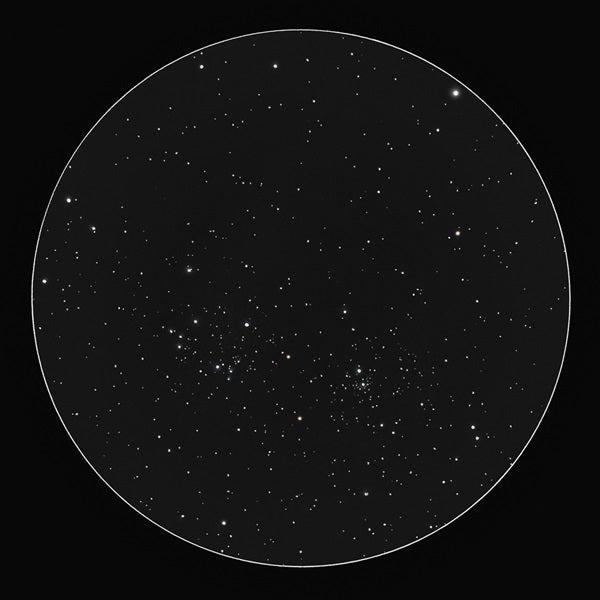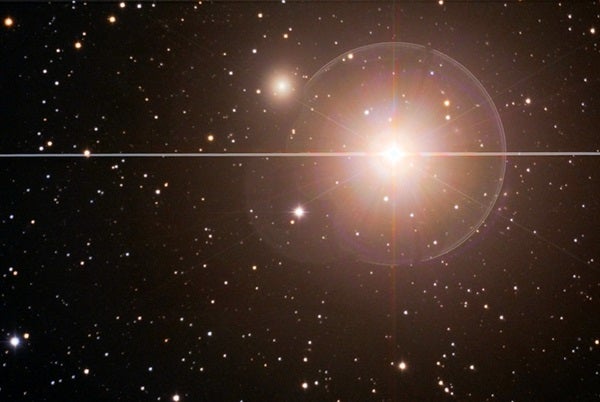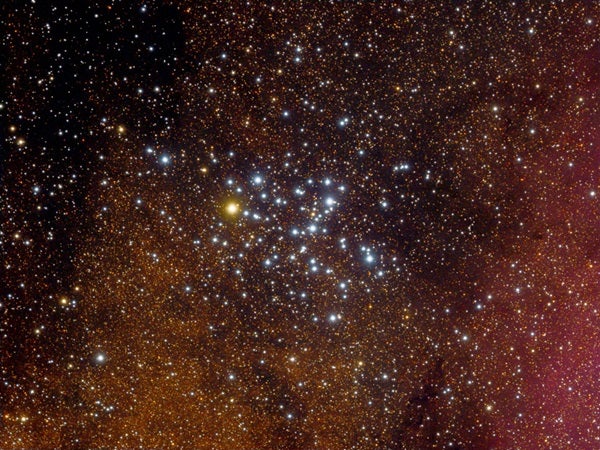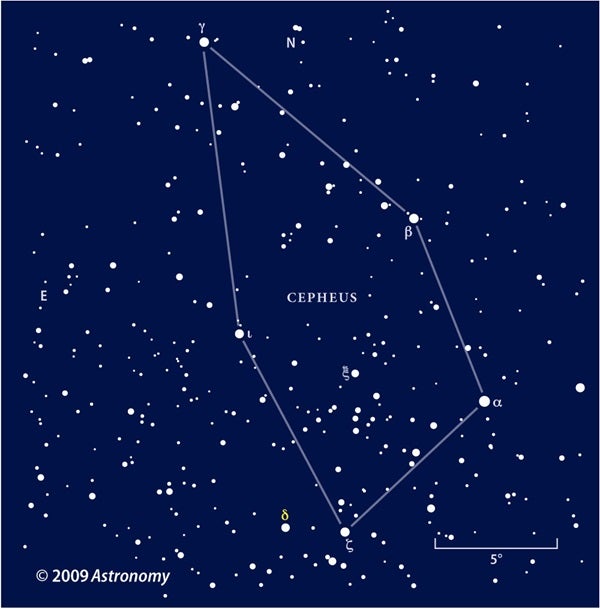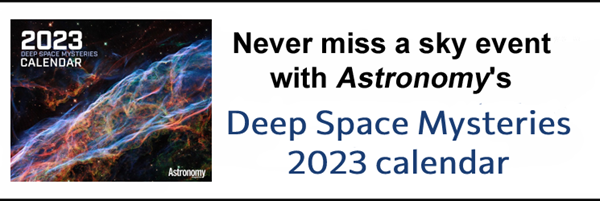Friday, August 26
Tonight, it’s a two-for-one deal: We’re observing the Double Cluster in Perseus.
Also cataloged as h and Chi (χ) Persei, as well as NGC 869 and NGC 884, respectively, these two young open clusters lie in northwestern Perseus, about 4° west of 4th-magnitude Miram (Eta [η] Persei). They are visible through binoculars or a telescope, though higher magnification will let you zoom in on only one at a time, while lower powers will let you see both simultaneously. They sit only about 30′ apart, with NGC 869 slightly west of NGC 884. NGC 869 is richer and more concentrated than its neighbor, but NGC 884 has brighter stars overall.
But wait, there’s more! Look 1.5° east of NGC 884 and you’ll spot what appears to be a small overdensity of stars: That’s NGC 957, yet another open cluster in the region. This loosely packed young cluster has two brighter stars amid many fainter ones and is a fun challenge to pick out amid the background stars.
Sunrise: 6:22 A.M.
Sunset: 7:41 P.M.
Moonrise: 5:24 A.M.
Moonset: 7:50 P.M.
Moon Phase: Waning crescent (1%)
*Times for sunrise, sunset, moonrise, and moonset are given in local time from 40° N 90° W. The Moon’s illumination is given at 12 P.M. local time from the same location.
Saturday, August 27
New Moon occurs at 4:17 A.M. EDT, leaving the skies dark for several days to get in some excellent deep-sky observing.
But first, Mercury reaches greatest elongation (27°) from the Sun at noon EDT. You can catch the magnitude 0.3 planet in the evening sky, still more than 5° high in the west 20 minutes after sunset. Through a telescope, the tiny planet appears 7″ across and 53 percent lit.
You may also see the thin crescent Moon — just 1 percent lit — about 20° to Mercury’s lower left at the same time, some 2° high. Our satellite is just 17 hours old; viewing such a young Moon is a real challenge that many observers savor.
Within about 50 minutes of sunset, Mercury has disappeared beneath the horizon and the brightest stars have popped out against the darkening background of twilight. Two bright beacons in the west are magnitude 1 Spica and magnitude –0.1 Arcturus. Compare and contrast the colors of these two stars: Spica is blue-white, while Arcturus appears orangey-red. That’s because Spica is a young type B star (actually, it’s two close-together B-type stars, which sit just 11 million miles [17.7 million kilometers] apart), while Arcturus is an older, cooler, red giant type K star.
Sunrise: 6:23 A.M.
Sunset: 7:39 P.M.
Moonrise: 6:27 A.M.
Moonset: 8:15 P.M.
Moon Phase: New
Sunday, August 28
Did you know you can see ghosts in the night sky? Second-magnitude Mirach (Beta [β] Andromedae) is rising in the northeast after dark. This bright red giant star shows off its pleasing orangey-red color in your telescope, but there’s something else as well: a haunting companion just 7′ to its northeast.
It’s not a stray reflection or a smudge on your eyepiece — this is Mirach’s Ghost, a dwarf lenticular galaxy sitting 10 million light-years beyond our own galaxy. Cataloged as NGC 404, this dim, small interloper can be hard to observe simply because the glare of much closer Mirach is so bright. The ease with which it can be mistaken for a reflection or other trick of the observer’s optics earned it its name. Although it is composed largely of old stars, NGC 404 also has a ring of young stars in its outskirts, suggesting that while it may be a ghost, it’s not completely “red and dead.”
Sunrise: 6:24 A.M.
Sunset: 7:38 P.M.
Moonrise: 7:31 A.M.
Moonset: 8:38 P.M.
Moon Phase: Waxing crescent (2%)
Monday, August 29
Venus dominates the morning sky as a blazing magnitude –3.9 light in the east, appearing about an hour before the Sun. It sits in western Leo, just under the head of the big cat as he climbs above the horizon with the dawn. The planet appears nearly full (97 percent lit) and 10″ across through a telescope.
Above (to the upper right of) Venus’ position in the sky is Cancer the Crab. If you’re out early enough, you may be able to spot the Beehive Cluster (M44) within it — the cluster is visible to the naked eye but in the growing twilight, binoculars or a telescope might serve you best. Above Cancer is Gemini the Twins. The two brightest stars in this constellation, Castor and Pollux, mark the figures’ heads. If you’ve still got your scope out, look at blue-white Castor to discover it’s not one star, but two through the eyepiece.
(Do make sure to put away your binoculars or telescope several minutes before the Sun rises from your location, which may be different from the time listed below.)
The delicate waxing Moon passes 7° north of Mercury at 7 A.M. EDT. Still visible after sunset, look west 30 minutes after our star disappears to find the pair now closer together — just over 6° apart — but our satellite now sits northeast of the small planet.
Sunrise: 6:25 A.M.
Sunset: 7:36 P.M.
Moonrise: 8:35 A.M.
Moonset: 9:01 P.M.
Moon Phase: Waxing crescent (6%)
Tuesday, August 30
Scorpius sits low on the southwestern horizon for a few hours after sunset. If you’ve got a clear view and a pair of binoculars, our targets tonight are two of the constellation’s many open clusters: M6 and M7. Both sit near the stinger stars Shaula and Lesath (Lambda [λ] and Upsilon [υ] Scorpii, respectively).
Going in numerical order, let’s start with M6. Also called the Butterfly Cluster, you’ll find this sparse grouping of stars 5° north-northeast of Shaula. You can likely see both at the same time by placing the star at the bottom of your field of view. And here’s where your imagination really comes into play: Some observers think this cluster looks like a butterfly with its wings spread, flying southeast — hence, its name. What do you think?
In the same field of view, just 3.8° southeast of M6 and 4.7° northeast of Shaula, is M7, also called Ptolemy’s Cluster. This one is so named because Ptolemy made mention of it around A.D. 130 in his famous Almagest. Larger and brighter than M6, this sparkling cluster has a conspicuous yellow-hued sun near its center, surrounded by bright blue stars.
Sunrise: 6:26 A.M.
Sunset: 7:35 P.M.
Moonrise: 9:40 A.M.
Moonset: 9:24 P.M.
Moon Phase: Waxing crescent (11%)
Wednesday, August 31
The mighty planet Mars sits just under 6° northwest of Aldebaran this morning, forming a pair of gleaming rubies in the predawn sky. Wait long enough and another ruddy point of light will join in: Betelgeuse in Orion, hanging below them in the east.
Mars rises shortly before midnight in the constellation Taurus, making the best times to view it currently the hours before dawn. The Red Planet is slowly approaching opposition, which it will reach in early December. That means the Mars observing season is now upon us, as its disk now stretches 10″ and will grow to nearly double this size in a few months. The planet appears 85 percent lit and will wax a few more percent by the end of next month. Now magnitude –0.1, Mars will also continue brightening until reaching its peak around opposition. So, Mars will only continue to grow more conspicuous among the background stars as time passes. Keep an eye on it as the year progresses!
Sunrise: 6:27 A.M.
Sunset: 7:33 P.M.
Moonrise: 10:46 A.M.
Moonset: 9:49 P.M.
Moon Phase: Waxing crescent (19%)
Thursday, September 1
With the start of September comes the opportunity to observe a very special star: The American Association of Variable Star Observers’ featured variable star of the month, Delta (δ) Cephei.
This 4th-magnitude star located in southeastern Cepheus the King is the archetype Cepheid variable. This class of variable stars has become a vital indicator that allows astronomers to measure the distance to faraway objects — including, perhaps most famously, the Andromeda Galaxy. A famous variable star identified in that galaxy by Edwin Hubble single-handedly settled the Great Debate over whether the Milky Way was the only galaxy in the entire universe.
What makes Cepheids so special? Cepheid variables follow a relationship called the Leavitt Law that links the star’s period — the time over which it brightens and dims — to its intrinsic brightness. Thus, using this law, researchers can measure a star’s period and derive its brightness, then compare it to how bright the star appears after it is dimmed by the distance between it and Earth. This comparison tells us how far away the star truly is.
An hour after sunset, Cepheus is already high in the northeast, swinging its way up and around the North Celestial Pole. The King is a roughly house-shaped constellation; Delta Cephei is about 2.5° due east of 3rd-magnitude Zeta (ζ) Cephei, which marks the lower left corner of the house when pictured upright. Tonight, about an hour after sunset, Delta will appear to the lower right of Zeta. Delta’s brightness cycles between magnitude 3.6 and 4.3 over the course of only about two weeks. If you come out to observe it night after night, you’ll likely notice how it changes relative to its neighboring stars.
Sunrise: 6:28 A.M.
Sunset: 7:32 P.M.
Moonrise: 11:55 A.M.
Moonset: 10:17 P.M.
Moon Phase: Waxing crescent (28%)
Friday, September 2
With no Moon in the sky, the first week of September is the perfect time to try to spot the zodiacal light. Also called the false dawn at this time of year because it appears before sunrise in the fall, this soft, cone-shaped glow arises from sunlight scattering off dust in the inner solar system. That dust has been left by the countless comets that have swung around our star, year after year.
To see the zodiacal light, you’ll need a dark observing site and a clear view of the eastern horizon. The higher in elevation you can get, the better, too. Look for a diffuse, almost ethereal light spiking upward from Leo through Cancer and Gemini. The zodiacal light is a popular subject for astrophotographers, particularly those who like to shoot nightscapes with interesting features in the foreground. Consider trying your hand at capturing this stunning glow on camera.
Sunrise: 6:29 A.M.
Sunset: 7:30 P.M.
Moonrise: 1:06 P.M.
Moonset: 10:52 P.M.
Moon Phase: Waxing crescent (38%)

